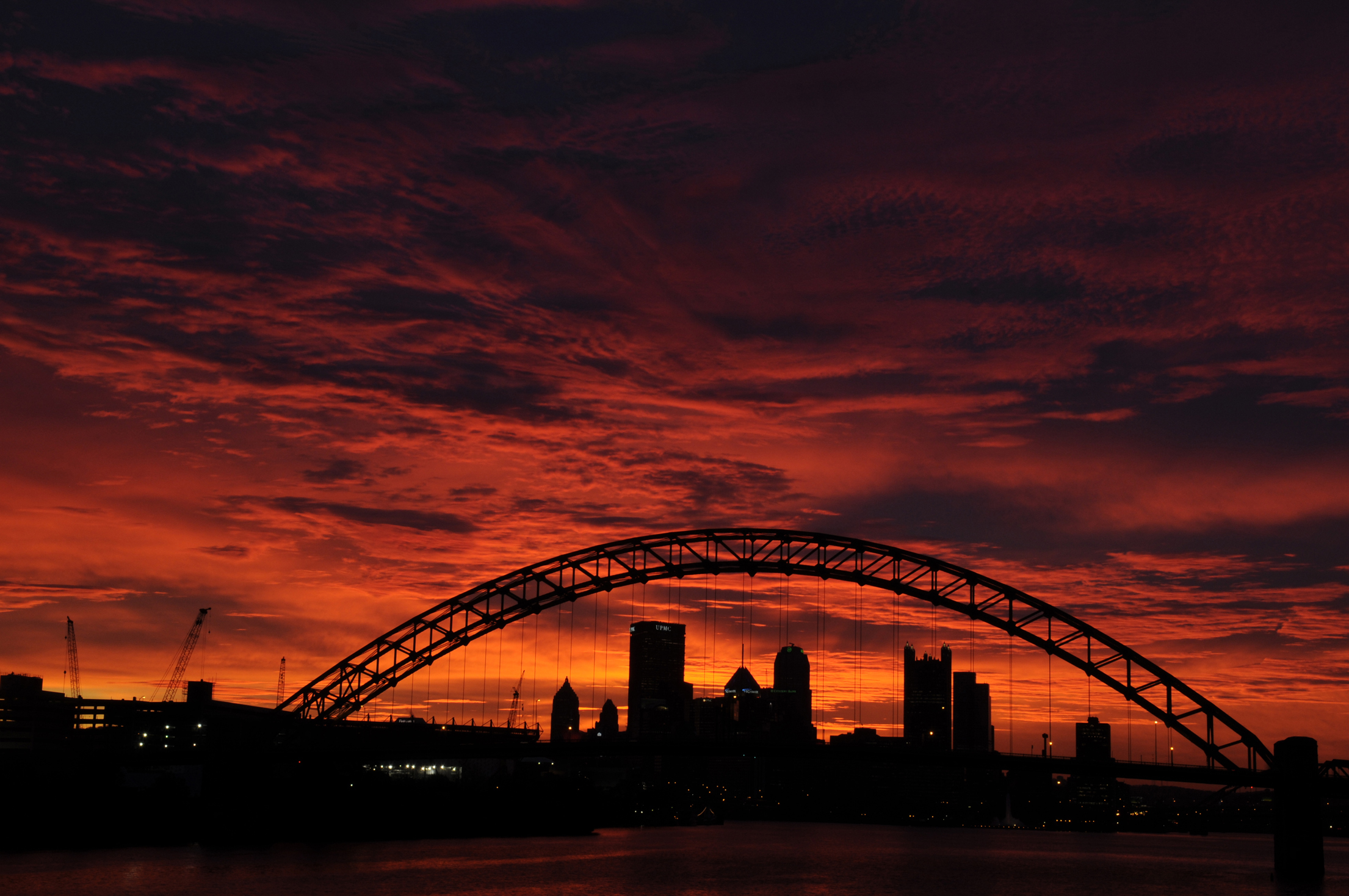With more than 1,400 bridges, the region is a permanent showcase of the inspired engineering and public art that make bridges great. My colleague Kevin Kirkland and I have been exploring them for a Pittsburgh Bridges series. Here are some of our functional and beautiful favorites.
West End Bridge
Located about a mile below Point State Park, this yellow bridge serves as the visual gateway to the Ohio River, which is formed by the confluence of the Allegheny and Monongahela rivers. Its most dramatic feature is a soaring through arch that is best experienced by driving under it. Opened in 1932, this bridge, which has pedestrian walkways on both sides, connects the West End with the North Side. On the Fourth of July, thousands of spectators gather on the bridge to watch fireworks. The West End Bridge underwent a major renovation in 1990 when four of its trusses were demolished to build new ramps, including ones that connected it to State Route 65.
Smithfield Street Bridge
The current Smithfield Street Bridge opened in 1883, a triumph of innovative design and an ode to arched steel and wrought iron. Its curvilinear form — a figure 8 turned on its side — and its 10-foot-tall Gothic finials with spikes make it the reigning monarch of Monongahela River bridges. At night, a pearl necklace of decorative lights illuminates its curved lenticular trusses. City architect Stanley Roush designed the portals, which feature grotesques of workmen. The bridge became a national historic landmark in May 1976, one year after some city and state officials suggested it be replaced. Preservationists and engineers objected, arguing that it was the oldest steel-truss bridge of its kind in the country. In 1993, the bridge underwent a $20-million rehabilitation and was repainted in historic colors; its lenticular trusses are dark blue, its underside is cinnamon, and its portals are buttercream.
The George Westinghouse Memorial Bridge
Rising 240 feet above the Turtle Creek Valley, the George Westinghouse Bridge has been compared by engineers to such wonders as the Holland Tunnel and the Hoover Dam. When it opened to traffic in 1932, the dedication ceremony drew 30,000 people. Named for the famous inventor, the bridge stands near the shuttered Westinghouse Electric Corp. plant. When it opened, the bridge was the largest structure of its kind in the country and its center arch, 425 feet long, was the longest reinforced concrete arch. At the entrances, local history is dramatized in 10-feet-by-18-feet art deco-style granite reliefs by sculptor Frank Vittor. The scenes show the defeat of British General Edward Braddock by the French and Indians in 1755, the steel industry and Westinghouse’s contributions to electricity and industry.
David McCullough (16th Street) Bridge
A symphony of steel arches and stone piers, the 16th Street Bridge — opened in 1923 — cost $1.25 million and was designed by the New York architectural firm of Warren & Wetmore. The firm’s structural engineer, Homer Gage Balcom, came to Pittsburgh to discuss the design with Allegheny County leaders, who wanted the span to be “beautiful as well as ornamental.” Topping the stone piers are bronze sea horses and large spheres encircled by zodiac signs. Mr. Balcom went on to design New York’s Empire State Building. When Pittsburgh native and historian David McCullough celebrated his 80th birthday in 2013 with a visit to his hometown, the bridge was renamed in his honor. As author of “The Brooklyn Bridge” and “The Path Between the Seas,” the historian knew that building and engineering bridges is nothing short of monumental.
Bridge of Sighs at the Allegheny County Courthouse
The Bridge of Sighs is a dramatic stone arch over Ross Street that connects two of Pittsburgh’s best-known landmarks. Prisoners once housed in the Allegheny County Jail (it now houses Family Court judges) crossed this bridge on their way to trials, hearings and sentencings at the imposing stone courthouse. Architect Henry Hobson Richardson designed both buildings. The name for this local architectural landmark was likely borrowed from the Italian version in Venice, which is made of white limestone and has windows with stone bars. Pittsburgh’s Bridge of Sighs appears in the 1984 movie, “Mrs. Soffel.” Starring Diane Keaton and Mel Gibson, the film was inspired by the true 1901 story of a jail warden’s wife who fell in love with a prisoner named Ed Biddle and helped him and his brother escape.




Comments
Login Register Logout